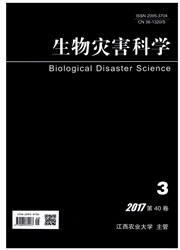

 中文摘要:
中文摘要:
达尔文提出建立在物竞天择、适者生存、优胜劣汰等主题之上的自然选择理论之后,又提出了物种进化的第二种选择——性选择:雄性为获得交配权而互相竞争,竞争结果是失败者并不像自然选择中的那样是死亡,而是失败者因没有获得交配而不能产生后代。如今,性选择理论已历时150年,随着无数科学家的努力及大量研究的开展,性选择理论已经得到了巨大地拓展和丰富,成为进化生物学领域里最活跃的研究主题。由于昆虫的生物多样性,性选择研究在昆虫学中占据重要地位并取得了丰硕的成果,有些进一步丰富和拓展达尔文的性选择学说和物种进化理论。以昆虫特有形态结构、生理特征和行为习惯等性状的性选择为基础,以分析昆虫性选择的模式和机制为目标,从不同时期性选择的表现形式、不同影响因素造成的性选择等,对昆虫性选择加以综合阐述。
 英文摘要:
英文摘要:
In Origin of Species, Darwin based his Theory of Evolution on the theme of the struggle for existence, the survival of the fittest and the preservation of favored races. After the theory of natural selection, he put forward the second option of the evolution, Sexual Selection, which pointed out that this selection depended, not on a struggle for existence, but on a struggle between males for possession of the females;the result of this struggle was not death to the unsuccessful competitors, but no offspring of them. Now, sexual selection theory has been born for 150 years. Due to the countless efforts and studies by scientists, sexual selection theory now has been greatly expanded and enriched and has become one of the most active research topics in the field of evolutionary biology. In this review, the form and nature of insects' sexual selection and their mechanisms were reviewed and discussed.
 同期刊论文项目
同期刊论文项目
 同项目期刊论文
同项目期刊论文
 Molecular characterization and functional analysis of a putative sex-peptide receptor in the tobacco
Molecular characterization and functional analysis of a putative sex-peptide receptor in the tobacco Development and emergence patterns of the tobacco cutworm Spodoptera litura (Lepidoptera: Noctuidae)
Development and emergence patterns of the tobacco cutworm Spodoptera litura (Lepidoptera: Noctuidae) Trade-off between adult body size and juvenile survival: an experimental test of parental effects in
Trade-off between adult body size and juvenile survival: an experimental test of parental effects in Reproductive traits of an Asian longicorn beetle Glenea cantor (F.) (Coleoptera: Cerambycidae: Lamii
Reproductive traits of an Asian longicorn beetle Glenea cantor (F.) (Coleoptera: Cerambycidae: Lamii 期刊信息
期刊信息
